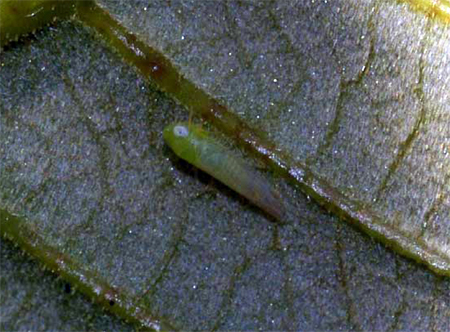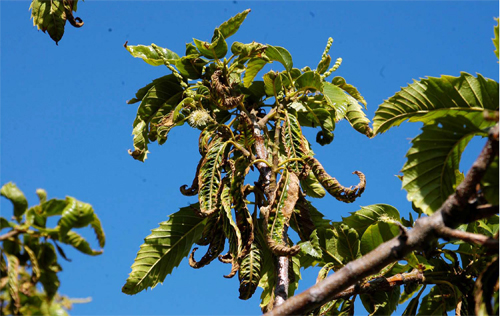Potato leafhoppers: A menace in chestnut orchards
If potato leafhoppers are present in chestnut orchards, when is it OK to spray and what sprays should you use?
Potato leafhopper is not native to the Great Lake’s Basin. It overwinters as an adult in the southeastern parts of the country. This unwelcomed guest from the south is brought by the storm fronts “riding” the high jet streams. Both adults and nymphs are pale green and can be easily recognized by their behavioral trait for moving sideways and backwards at a fast pace.

Potato leafhopper. Photo credit: Mario Mandujano.
Potato leafhoppers feed near the edges of the leaves by piercing the tissue and sucking up the juicy content of the cells. Evidence of feeding manifests itself as whitish, almost bleached dots arranged in triangular shapes near the edges. Under the heavy invasion of these little destroyers, leaf edges have a burned-like appearance; they start curling and fall off. In most severe cases, leaf function is severely obstructed. Leaves are small, bunched up and practically nonfunctional. As a consequence, the yield is greatly reduced.

Potato leafhopper damage on chestnut leaves. Photo credit: Mario Mandujano.
I was in my local area of west central Michigan a couple of days ago and had the opportunity to check a chestnut orchard just outside of Lansing. As I was browsing around, familiar symptoms popped right into my face. Taking a closer look, I wasn’t surprised to find a couple of potato leafhoppers running across the leaf blade in all directions. Now the question is: To spray, or not to spray? Thresholds will vary widely depending on the host. For chestnuts, if there are more than three leafhoppers per leaf, application is warranted.
Spray options include Provado, Admire-Pro, Baythroid XL and Laverage (combination of Cyfluthrin and Imidacloprid).



 Print
Print Email
Email

